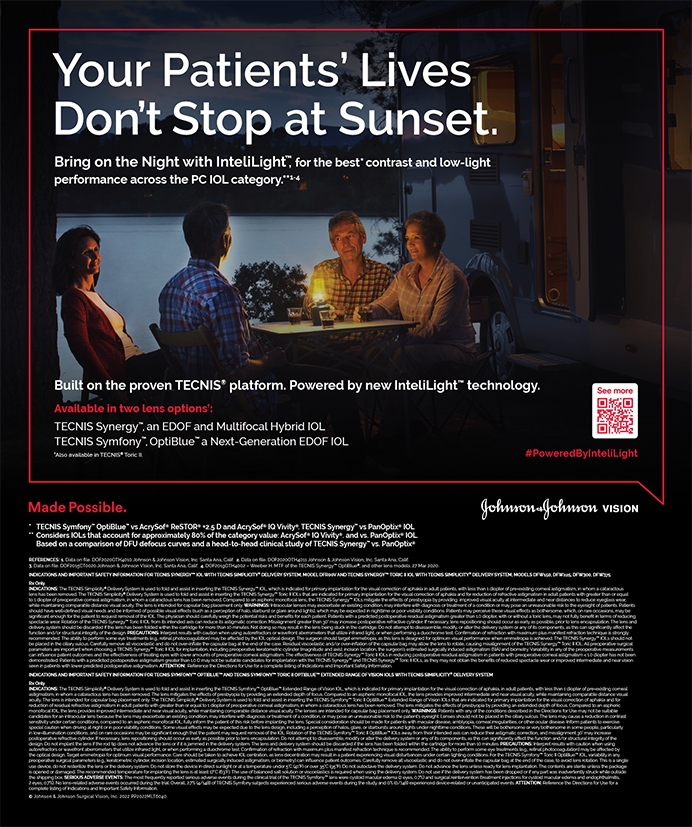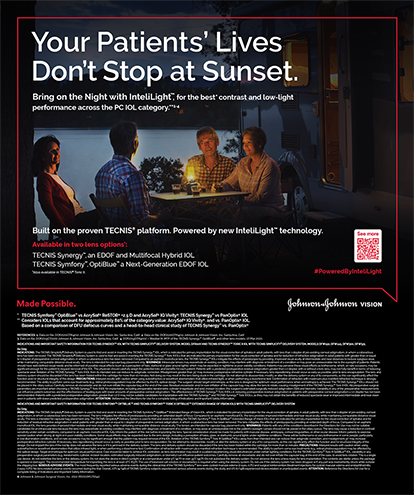CASE HISTORY
In 1995, a 50-year-old white female underwent bilateral radial keratotomy that targeted plano for -4.50 D of myopia. She was undercorrected, so the surgeon performed myopic automated lamellar keratomileusis (ALK) on her right and left eyes in 1995 and 1996, respectively. The right eye experienced secondary hyperopia, while the left eye remained myopic. Next, the surgeon performed LASIK on the patient's left eye using the Chiron ACS (Bausch & Lomb Surgical, San Dimas, CA) in 1998 and on her right eye in 1999 with the Hansatome microkeratome (Bausch & Lomb Surgical).
The patient presented in my office with complaints of poor nighttime vision and halos around lights at night. Glasses had not improved her symptoms. She had a bilateral UCVA of 20/60. The patient had a manifest refraction of +0.75 +0.25 X 35 and a BCVA of 20/25-2 OD. The manifest refraction and BCVA of her left eye were +0.50 +0.75 X 165 and 20/25. The slit lamp examination showed well-healed RK scars, as well as a relatively small but thick ALK flap in both eyes (Figure 1).
Each eye's LASIK flap was larger and thinner than its ALK flap. The steep transition zone was evident on the peripheral topography (blue edge to red edge) (Figure 2), corresponding with 38.00 D centrally to 45.00 D peripherally. The patient's pupils were 7.5 mm, extending beyond the edge of the color topography map and signifying that spherical aberrations factored into the patient's complaints. Her central pachymetry measurements were 492 µm OD and 539 µm OS. The remainder of the examination was unremarkable.
HOW WOULD YOU PROCEED?1. Would you perform an enhancement on a patient with two flaps per eye?
2. How would you relift the flap?
3. By what method would you enlarge the optical zone?
SURGICAL COURSE
Improving the patient's symptoms entailed one of the following options: (1) decreasing her pupil size or (2) enlarging her optical zone. The patient experienced minimal success with Alphagan P ophthalmic solution (Allergan, Inc., Irvine, CA), so I decided to enlarge her optical zones using the LADARVision4000 (Alcon Laboratories, Inc., Fort Worth, TX), an excimer laser platform capable of producing large optical zones. My goal was to isolate and lift each LASIK flap without disturbing the thicker ALK flaps, after which I would apply a wider laser treatment in order to expand the functional optical zone of each eye without inducing hyperopia. Inadvertently lifting the ALK flaps would increase the patient's risk of ectasia, because the residual stromal bed would be thinner than 250 µm.
I treated the patient's right eye first. I have found it necessary to adjust my LASIK nomogram for cases such as this one. When using the LADARVision platform and a 7.0-mm optical zone, I normally program the original attempted correction, fire off the first 75% of laser pulses onto eye-tracking paper, and apply only the remaining 25% to the keratectomy bed after lifting the flap. In this case, I targeted -1.25 D in an effort to augment the patient's reading vision. I programmed the laser for -4.50 D (the patient's original spectacle prescription) at a 7.0-mm optical zone, rather than a 7.5-mm optical zone, in order to minimize the depth of the laser treatment. I applied the first 75% of the laser treatment to eye-tracking paper.
After positioning the patient under the laser, I dissected the nasal edge of her original LASIK flap to ensure that I would not initially enter the nasally hinged ALK flap interface. Using a cyclodialysis spatula, I gently entered the interface and bluntly dissected the interface from the deeper ALK flap. I have also found this technique useful for minimizing the risk of opening RK incisions during the flap-lifting stage of the LASIK procedure. I was able to lift the flap carefully without disturbing the ALK interface or compromising the integrity of the RK incisions. Next, I applied the remaining 25% of the laser treatment. To counteract a potential postoperative hyperopic shift, I applied a +1.00 D treatment immediately following the myopic treatment, prior to repositioning the flap.
OUTCOME
At 3 months, the patient's uncorrected near vision in her right eye was 20/200, and her manifest refraction was +0.75 +0.75 X 44, yielding a BCVA of 20/30. Corneal topography showed a decreased power transition in the periphery (42.00 D) that corresponded to the patient's reduced spherical aberrations (Figure 3). She was very happy with the improved nighttime vision in her right eye.
In order to improve her reading vision, I performed a flap-lift enhancement by attempting to treat +2.40 D (the spherical equivalent of the pre-existing hyperopia was +1.10 D, and I added +1.30 D for a postoperative reading target of -1.30 D). I programmed the laser for +1.70 D (a 30% decrease in the programmed amount due to a nomogram adjustment). Three months following the enhancement procedure, the patient's uncorrected near vision was 20/40, and her manifest refraction was -1.00 D sphere, yielding a BCVA of 20/25-1.
The patient later underwent a similar procedure in her left eye with a target of plano. The procedure differed from the first retreatment in two ways. First, because the ALK and LASIK flaps were nasally based, I marked the LASIK flap's edge at the slit lamp in order to create “landmarks” for flap dissection under the laser. Second, I increased the second-stage hyperopic treatment by +2.00 D to prevent the small hyperopic effect that occurred in the patient's right eye. At 6 months postoperatively, the patient's UCVA OS was 20/30, her manifest refraction was plano +0.75 X 20, and her BCVA was 20/25+2. Corneal topography showed greater flattening in the periphery that reduced the amount of spherical aberrations (Figure 4). The patient was very happy with her improved nighttime vision in this eye as well.
Brian S. Boxer Wachler, MD, is Director of the Boxer Wachler Vision Institute in Beverly Hills, California, and a faculty member at the University of California, Los Angeles. He is a consultant for Alcon Laboratories, Inc. He holds no financial interest in any of the products mentioned herein. Dr. Boxer Wachler may be reached at (310) 860-1900; bbw@boxerwachler.com.

